#charles den tex
Explore tagged Tumblr posts
Text
Turen går til Tasmanien part 3/3
Torsdag (Strahan - Hobart):
Sidste dag på touren er nu kommet og gået. Vi skulle fra Strahan tilbage til Hobart, hvilket er en lang køretur, hvor vi dog tog et par stop på vejen.

Første stop var vi ved Queenstown, som er en gammel mineby. Området omkring denne by er meget specielt, da det har været stærkt påvirket af syreregn. Minebyen havde ikke mere træ at brænde af til at smelte det kobber de havde brug for, derfor begyndte de at brænde pyrit af i stedet for. Dette gjorde at de havde helt vildt meget syreregn i meget lang tid, hvilket fuldstændig ødelagde beplantningen omkring byen. Det var altså et meget specielt naturområde at køre igennem, i det ellers meget frodige Australien. Her så vi også Iron Blow, hvilket var virkelig smukt!

Efterfølgende stod dagen på endnu flere vandfald og meget høje træer! Vi var i Mount Field National Park, hvor de har træer op til 70-80 meter høje. Det var så smukt at gå igennem.


Udover de høje træer, så vi også to helt vildt flotte vandfald, Horselook waterfall og Russels waterfall.
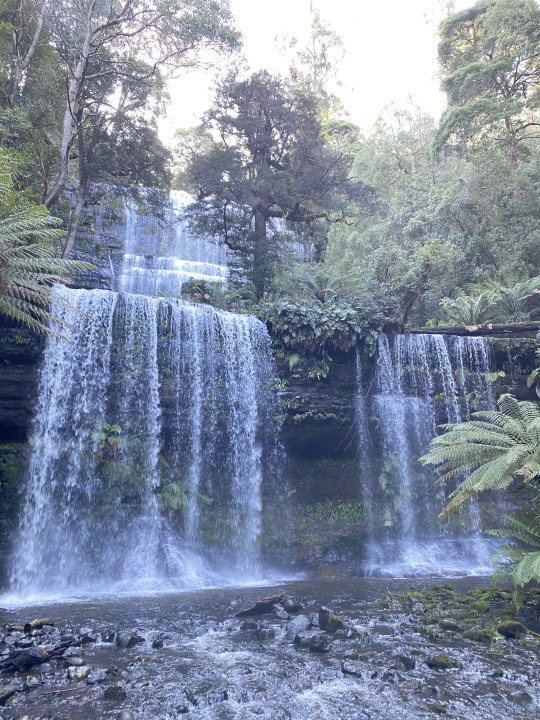


Og for det ikke sku være helt løgn, fik jeg set endnu et næbdyr. Hvor heldig kan man være. Denne gang var næbdyret dog en del længere væk, og havde kun bagenden oppe i vejret. Jeg fik altså en virkelig dårlig video, men jeg har nu bevis på at have set det underlige og fantastiske dyr :)))
Jeg er nu tilbage i Hobart, men jeg har heldigvis en dag mere i skønne Tasmanien. I morgen skal dagen brugen på en allersidste vandretur, inden jeg vender hjem til det varme Brissie igen.
Fredag (Hobart - Brisbane):
Min sidste dag i Hobart blev brugt på Mount Wellington. Jeg vågnede tidligt og tog den første bus til Fern Tree som er trailhead for vandreturen til toppen af Mount Wellington. Det startede godt ud med omkring 1,5 times regnvejr på vej op af bjerget.

Da regnen så endelig stoppede, var det altså ikke fordi, der var skyfrit, men fordi jeg var havnet midt i den regnene sky. Og der var bare smæk på blæsten. Det var mildest talt meget koldt og vådt, især fordi min genbrugs Gore-Tex jakke altså ikke viste mange Gore-Tex egenskaber. Den dæmpede lidt for vinden, men jeg var blevet drivvåd inden under den… det er det der sker, når man køber en “regnjakke” for 16AUD i en op-shop (genner). Men jeg kom altså hele vejen op til summit, hvor der var udsigts post. Her kunne jeg komme indenfor i ly for blæsten, men det var altså ikke meget udsigt, jeg kunne nyde.



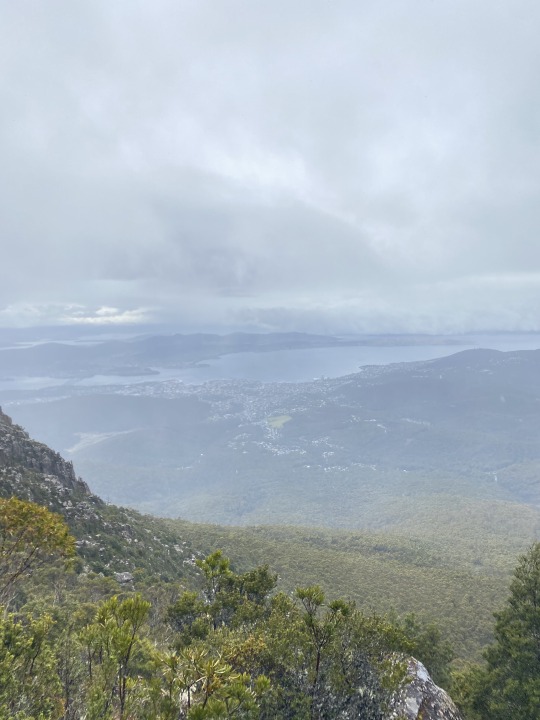
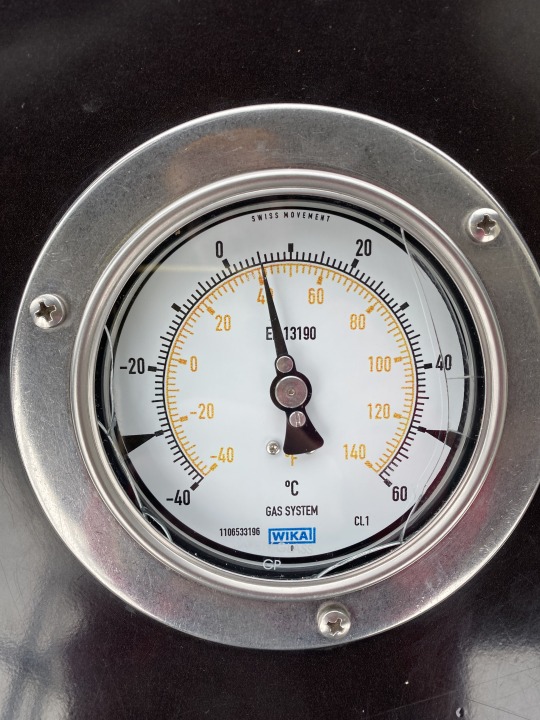

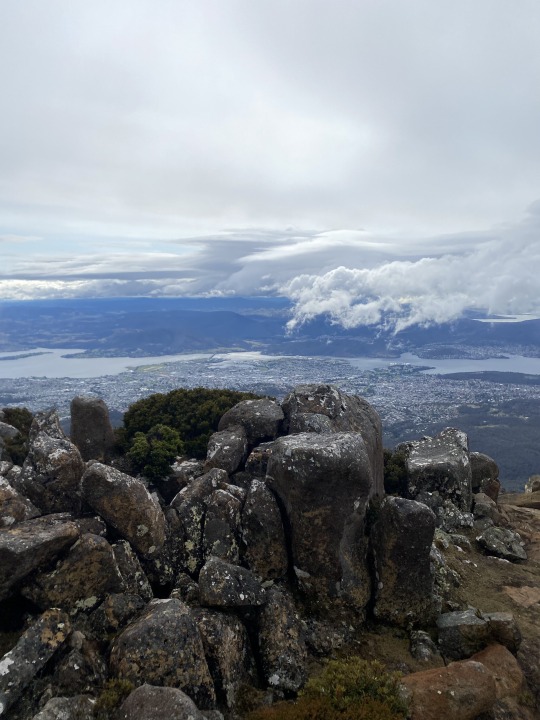

Jeg holdte en god lang pause her, mest fordi jeg frygtede at bevæge mig udenfor igen, hvor jeg derefter navigerede ned af bjerget igen. Denne gang af en anden rute. Denne rute holdte på det skyede blæsevejr lidt længere, men da jeg ENDELIG brød ud af tåen fandt jeg mig i det smukkeste natur. Jeg var helt vild med det. Og for det ikke skulle være helt løgn, kom solen endelig frem! Jeg kunne altså skifte til min sweater, som lå helt tør i tasken, og gå ned af bjerget uden det kolde våde tøj på. Det var altså en meget dejlig vandretur alligevel ;))


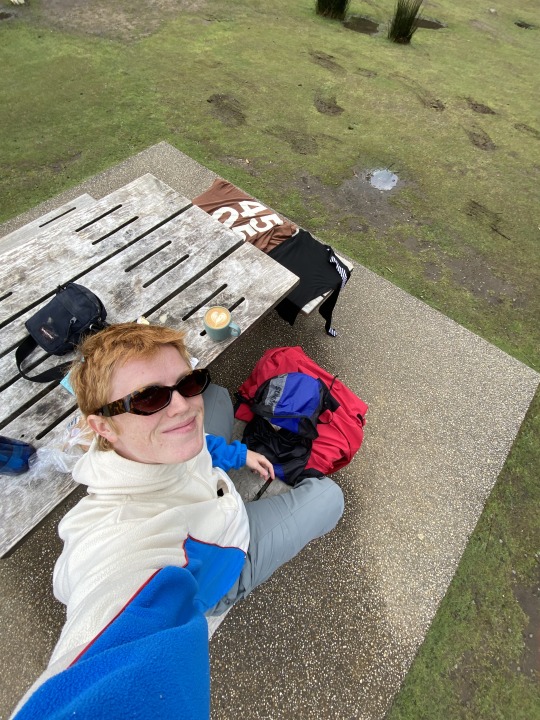
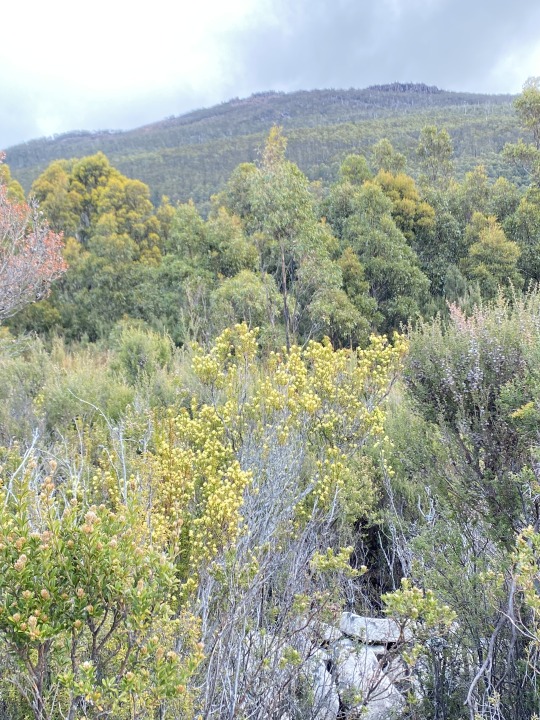

Efter vandreturen tog jeg bussen tilbage til Hobart, hvor jeg fik et par timer til at gå, inden jeg skulle i Hobart lufthavn, den mindste lufthavn jeg nogensinde har været i. Jeg fik besøgt Tasmaniens museum, som btw er gratis, hvilket havde en virkelig fed udstilling om Charles Dickens. Her synes museumsvagten at min hvide hoodie var helt fantastisk til et af udstillingsrummene, så i får også lige hans meget kunsteriske billeder med i købet.

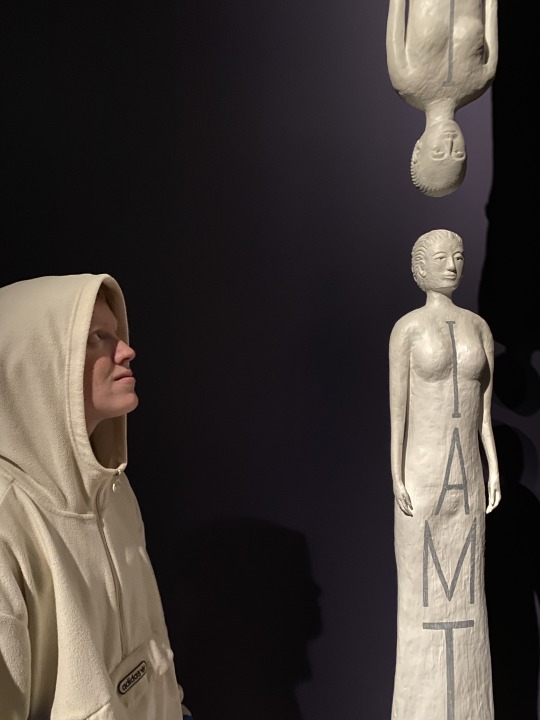

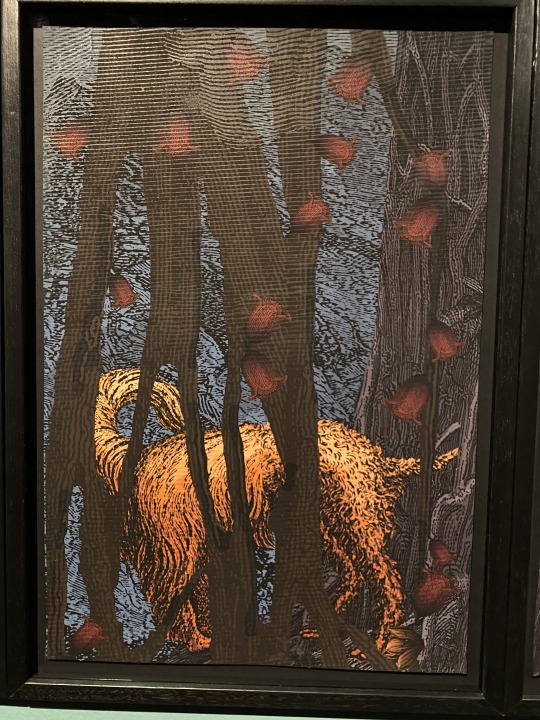
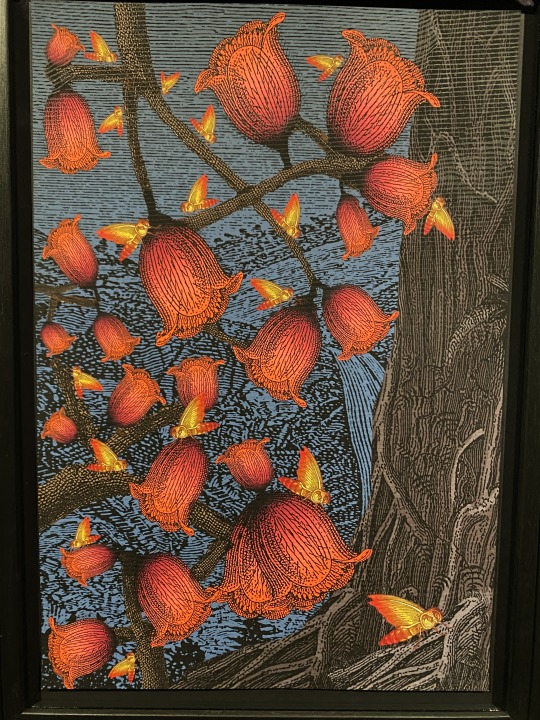
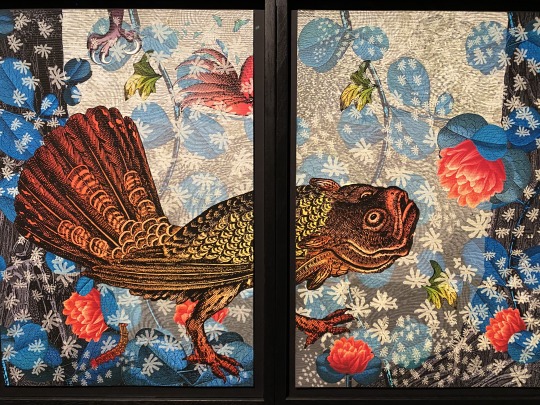

Nu hvor turen virkelig er slut, står jeg kun tilbage med en følelse: jeg MÅ tilbage. Dette er virkelig er helt fantastisk sted, med helt fantastisk natur. Jeg kan slet ikke dulme min begejstring for Tasmanien. Jeg tror muligvis dette bliver mit højdepunkt for Australien. Det er altså lidt bedrøvet, at jeg vender snuden hjem til Brissie, meeen efter den mildt våde vandretur, lyder det da også lidt rart med noget sol og varme igen :)))
4 notes
·
View notes
Text
Cel
(flaptekst)
Michael Bellicher, is getuige van een auto-ongeluk met fatale afloop. Na te zijn verhoord, wordt hij gearresteerd. Waarom is niet duidelijk, maar de politie is ervan overtuigd dat ze hem moeten hebben. Michael weet niet eens waarvoor. Alles wat hij zegt, lijkt zich tegen hem te keren. Hij wordt overgebracht naar een politiebureau in het Westland. Daar krijgt hij te maken met twee rechercheurs, een rare aanklacht, een onvermijdbaar bewijs en een advocate die hem niet gelooft. En dan moet de ellende nog beginnen.

Het boek lijkt over een interessant onderwerp te gaan en ik hoop dat er veel actie is. Ik vind het belangerijk dat er veel spannening is, het geeft mij motivatie om verder te lezen. Ik kijk er naar uit om dit boek te lezen en het boek met jullie te delen.
0 notes
Text
More Blaxploitation Music
The Blaxploitation Movies of the 1970’s were the first films made by black crews for black audiences. Filmmakers turned to black musicians to score their films and add an extra touch of soul and featured artists such as Curtis Mayfield, Willie Hutch, Isaac Hayes and Marvin Gaye. Here’s our essential selection of 1970′ blaxploitation soundtracks.

Blaxploitation Music
Aragon - Roy Ayers (Coffy, 1973)
Betty's Theme - Charles Earland (The Dynamite Brothers (Original Motion Picture Soundtrack Recording), 1974)
Bring It On Down To Me - Pt I - Bobby Franklin’s Insanity (Bring It On Down To Me - Pt I / Bring It On Down To Me - Pt II, 1969)
Car Wash - Rose Royce (Car Wash: Original Motion Picture Soundtrack, 1976)
Coffy Is The Color - Roy Ayers (Coffy, 1973)
Dolemite - Rudy Ray Moore featuring Ben Taylor (Rudy Ray Moore Is “Dolemite” (From The Original Motion Picture Soundtrack), 1975)
Father’s Lament - Grant Green (The Final Comedown - Original Motion Picture Soundtrack, 1972)
The Hitter - Garfeel Ruff (The Hitter (Music From The Motion Picture), 1979)
I’ve Got To Find A Way (To Hide My Hurt) - Moses Dillard and The Tex Town Display (I’ve Got To Find A Way (To Hide My Hurt) / I’ve Got To Find A Way (To Hide My Hurt) Part II, 1970)
Lialeh - Bernard Pretty Purdie (Lialeh (Original Movie Sound Track), 1974)
Make It Right - J.J. Johnson (Willie Dynamite (Music From The Original Motion Picture Soundtrack), 1974)
Sheba, Baby - Monk Higgins and Alex Brown featuring Barbara Mason (Sheba, Baby, 1975)
Steve’s Den - Nat Dove and The Devils (Petey Wheatstraw - The Devil’s Son-In-Law (Original Soundtrack From The Motion Picture), 1977)
Theme from Cleopatra Jones - Joe Simon (Cleopatra Jones (Original Soundtrack From The Motion Picture, 1973)
Where Do I Go From Here (Sonny Carson’s Theme) - Coleridge-Taylor Perkinson - The Education Of Sonny Carson (Original Motion Picture Soundtrack), 1974)
WW III - Luchi DeJesus – Friday Foster (Original Motion Picture Soundtrack), 2001, originally from 1975)
More Soul Music Lists
The best blaxploitation soundtracks
More Blaxploitation
31 notes
·
View notes
Text
Cel
Hallo iedereen, vanaf vandaag zal ik aan een nieuw boek beginnen. Het boek dat ik gekozen heb heet ‘cel’ van Charles Den Tex. Het gaat over Michael Bellicher, die een auto ongeluk overleeft, maar hij komt erachter dat iemand zijn identiteit gebruikt.
Het ziet er zo uit:

uitgeverij: De Geus
jaartal: 2018
schrijver: Charles Den Tex
bladzijden: 384
Ik zal om elke 8 hoofdstukken jullie updaten over wat er gebeurd is!
5 notes
·
View notes
Text
Mindhunter, anden årgang
4 ud af 5 barnemordere
Anden årgang af David Finchers skildring af den spæde start på FBI’s profiler-afdeling sidst i halvfjerdserne begynder, hvor den slap. De to hovedpersoner, agenterne Ford og Tench, fortsætter deres interviews af seriemordere for at blive kloge på, hvad der driver dem. Vi møder David Berkowitz (Son of Sam), Charles Manson og Tex Watson (en af morderne fra Mansons “familie”). Samtidig får vi et par sidehistorier koncentreret om Tench og dr. Wendy Carr, det tredje prominente medlem af gruppen. Hovedhistorien skifter undervejs til ren police procedure med efterforskningen af en aktuel sag, nemlig barnemordene i Atlanta (1979-81). Ligesom første årgang god, begavet og velproduceret underholdning for intelligente mennesker. Der lægges klart op til en tredje sæson, og den glæder vi os til.

1 note
·
View note
Text
Elvis Film Stream German Online Komplett Kostenlose
Film stream - https://elvis-deu.blogspot.com/
Die Geschichte vom atemberaubenden Aufstieg zum Musical-Olymp des Rock’n’Roll-Königs Elvis Presley, der mit einer Bekanntschaft mit Manager Tom Parker begann und sich mit unglaublichen Höhen und Tiefen fortsetzte.
Die Vorliebe von Moulin Rouge-Regisseur Baz Luhrmann für schicke, schillernde musikalische Exzesse findet in Elvis, einem von der Wiege bis zur Bahre reichenden Biopic des King of Rock 'n' Roll, dessen trauriges und tragisches Ende als Cashcow in Las Vegas ein passendes Thema ist eine Gatsby-ähnliche Kritik an der selbstmythologisierenden Natur des amerikanischen Traums. Luhrmanns letzter Film war natürlich seine absichtlich übertriebene Adaption von F. Scott Fitzgeralds Klassiker, und er bringt viele seiner stilistischen Exzesse in Presleys Leben ein, wenn auch auf eine Weise, die nicht nur die Oberflächlichkeit des Showbusiness einfängt das Geld übernimmt, aber der Nervenkitzel eines Phänomens, während es Gestalt annimmt.
Mit dem relativ unbekannten Austin Butler als Presley und einem prothetisch pummeligen Tom Hanks als seinem alles kontrollierenden Manager Colonel Tom Parker verwendet der Film Parker als seinen unzuverlässigen Erzähler und beginnt 1997 mit Parker am Ende seines Lebens, voller Selbstbewusstsein - Schade, als er erzählt, wie er zum Bösewicht dieser Geschichte geworden ist. Das ist er zweifellos auch. Als Jahrmarktsverkäufer mysteriöser Herkunft sieht er in dem Moment, in dem er Elvis zum ersten Mal hört, Dollarzeichen und zwingt ihn, während einer Szene, die Luhrmann in einem Jahrmarkt-Spiegelkabinett inszeniert, einen exklusiven, ausbeuterischen Vertrag zu unterschreiben – ein unheilvolles Vorzeichen der desorientierenden Realität, in der er sich befindet kurz davor, Elvis zu besetzen.
Hanks' krötenhaftes Auftreten und sein komisch absurder Euro-Pudding-Akzent untergraben sein eigenes Image als netter Kerl mit einem überzeugend grotesken Effekt und stehen sicherlich in deutlichem Kontrast zu dem rein amerikanischen Jungen, den Parker der Welt verkaufen möchte. Doch Butlers Casting als Elvis ist auch schlau. Er ist vielleicht nicht so hübsch wie Presley in seiner Blütezeit (obwohl realistisch, wer ist das?), aber als ehemaliger Kinderschauspieler, dessen prominenteste Rolle als Erwachsener bisher Charles Mansons Schüler Tex Watson in Once Upon a Time war … in Hollywood, er vermittelt die Unschuld und Gefahr, die Elvis zu einer so ernst zu nehmenden Kraft machten, als er zum ersten Mal auftauchte.
Diese frühen Auftrittsszenen sind besonders gut. Luhrmann verwendet ein ganzes Arsenal an Crash-Cuts und Schritt-Zooms, um die hormonentsaftende, Unterwäsche dämpfende Erregung darzustellen, die Elvis und sein Becken in Dutzenden von Mädchen, Frauen und Jungen auslöst, die es nicht gewohnt sind, sich ihren eigenen sexuellen Begierden zu stellen. Aber er achtet auch darauf, die Abstammung schwarzer Künstler anzuerkennen, deren Musik Elvis als drecksarmes weißes Kind, das in einem überwiegend schwarzen Viertel aufgewachsen ist, von Osmose aufgenommen hat. Der Film schneidet Performance-Sequenzen seiner gesamten Karriere mit Szenen, in denen Elvis sich als Kind in Bluesclubs und Gospelkirchen schleicht, und präsentiert Elvis‘ Musik nicht als Akt kultureller Aneignung (zumindest nicht seinerseits), sondern eher als unbewusste Verschmelzung von Stilen von jemandem, der seine Herkunft respektierte.
Elvis online film Elvis filme stream Elvis filme stream DF Elvis film de Elvis in voller lange anschauen Elvis Film online anschauen Elvis voll kostenlos sehen Elvis kostenlos online anschauen Elvis voll anschauen Elvis kostenlos angucken Elvis film kostenlos Elvis kostenlos film schauen Elvis film kostenlos anschauen Elvis kostenlose film Elvis kostenlos film online schauen Elvis kostenlos videos Elvis deutsche film online
#Elvis filme stream#Elvis filme stream DF#Elvis online film#Elvis Film online anschauen#Elvis voll kostenlos sehen#Elvis kostenlos film online schauen
1 note
·
View note
Text
Gisteren was ik mijn boek aan het lezen cel van Charles Den Tex. Nadien ging ik tv kijken en er was een aflevering van Law en Order een Amerikaans serie die zaken oplossen gebasseerd op echte misdaden. In deze aflevering ging het over een jonge man die opgepakt werd door de politie en gevangen genomen voor een misdaad die hij niet heeft gedaan . Het herrinerde me het context van mijn boek. In het verhaal wordt de hoofdpersonage Michael ook gevangen genomen voor een misdaad die hij niet heeft gedaan.
0 notes
Text
TOAST OF THE TOWN aka THE ED SULLIVAN SHOW
“A Tribute to Lucy and Desi” (S3;E8) ~ October 3, 1954
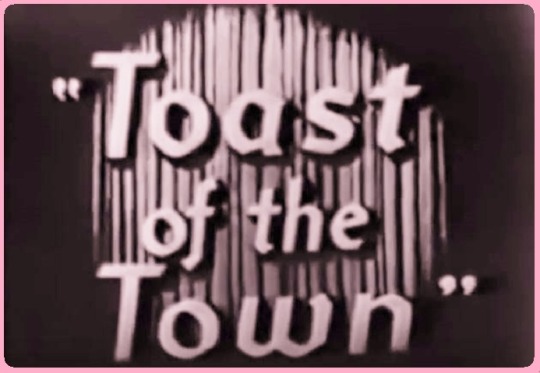
Directed & Choreographed by John Wray
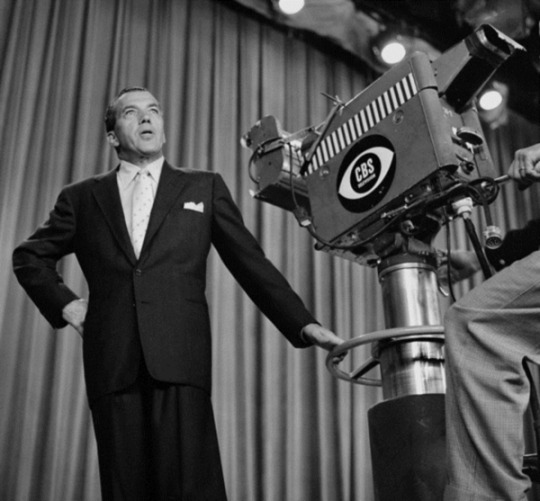
Ed Sullivan (Himself / Host) was a preeminent television variety show host who is best remembered for hosting his own show, at first titled “Toast of the Town” but later simply known as “The Ed Sullivan Show,” which became a staple of Sunday night viewing for millions of Americans from 1948 to 1971. As such, his name was often mentioned on “I Love Lucy” and Lucille Ball's subsequent sitcoms. He introduced America to such entertainers as Elvis Presley, The Beatles, and The Supremes. Sullivan entered icon status when he and his television show were worked into the plot of the Broadway musical Bye Bye Birdie in 1960. The musical includes the song "Hymn for a Sunday Evening" which has a chorus that repeats Sullivan's name in a choir-like harmony. Hope made an appearance in the 1964 film version. The theatre on Broadway in New York City where Sullivan did his weekly show was named after him in 1967. He died in 1974.
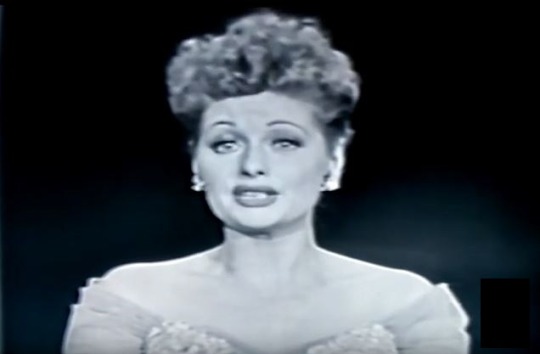
Lucille Ball (Herself / Lucy Ricardo) was born on August 6, 1911 in Jamestown, New York. She began her screen career in 1933 and was known in Hollywood as ‘Queen of the B’s’ due to her many appearances in ‘B’ movies. With Richard Denning, she starred in a radio program titled “My Favorite Husband” which eventually led to the creation of “I Love Lucy,” a television situation comedy in which she co-starred with her real-life husband, Latin bandleader Desi Arnaz. The program was phenomenally successful, allowing the couple to purchase what was once RKO Studios, re-naming it Desilu. When the show ended in 1960 (in an hour-long format known as “The Lucy-Desi Comedy Hour”) so did Lucy and Desi’s marriage. In 1962, hoping to keep Desilu financially solvent, Lucy returned to the sitcom format with “The Lucy Show,” which lasted six seasons. She followed that with a similar sitcom “Here’s Lucy” co-starring with her real-life children, Lucie and Desi Jr., as well as Gale Gordon, who had joined the cast of “The Lucy Show” during season two. Before her death in 1989, Lucy made one more attempt at a sitcom with “Life With Lucy,” also with Gordon, which was not a success and was canceled after just 13 episodes.
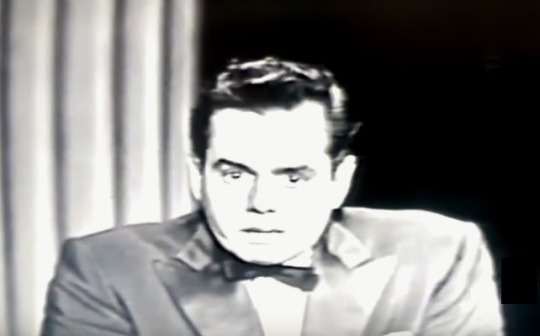
Desi Arnaz (Himself / Ricky Ricardo) was born in Cuba in 1917 and immigrated to America as a youngster. He was a musician who married Lucille Ball in 1940 after meeting her on the set of 1939’s Too Many Girls, which he had done on stage in New York. In order to keep him ‘off the road’ Ball convinced producers to cast him as her husband in a new television project based on her radio show “My Favorite Husband.” The network was convinced. In 1951, Arnaz and Ball began playing Lucy and Ricky Ricardo, roles they would be identified with for the rest of their lives. The couple had two children together, Lucie and Desi Jr. In 1960, Ball and Arnaz divorced. Desi became a producer, responsible for such hits as “The Mothers-in-Law” (1967-69). He re-married in 1963. Desi Aranz died in 1986, just a few years before Ball.

William Frawley (Himself / Fred Mertz) was already a Hollywood veteran when he was hired by Desi Arnaz to play Fred Mertz on “I Love Lucy.” After the series concluded he joined the cast of “My Three Sons” playing Bub Casey. He did an episode of “The Lucy Show” in October 1965 which was his final TV appearance before his death in March 1966.
Vivian Vance (Herself / Ethel Mertz) was born Vivian Roberta Jones in Cherryvale, Kansas in 1909, although her family quickly moved to Albuquerque, New Mexico where she was raised. She had extensive theatre experience, co-starring on Broadway with Ethel Merman in “Anything Goes.” She was acting in a play in Southern California when she was spotted by Desi Arnaz and hired to play Ethel Mertz, Lucy Ricardo’s neighbor and best friend. The pairing is credited with much of the success of “I Love Lucy.” Vance was convinced to join the cast of “The Lucy Show” in 1962, but stayed with the series only through season three, making occasional guest appearances afterwards. She made a total of six appearance on “Here’s Lucy.” She also joined Lucy for a TV special “Lucy Calls the President” in 1977. Vance died two years later.
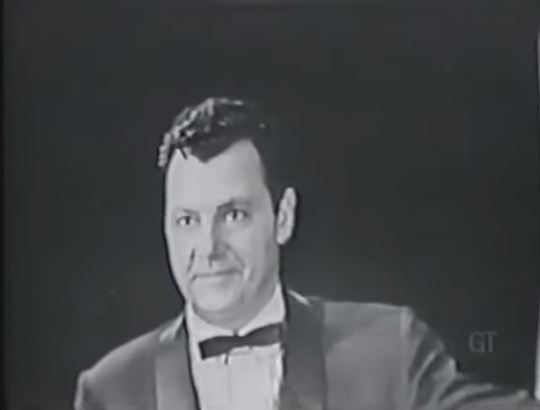
Harry Chesney (Himself) was the vice-president of Philip Morris, the tobacco company that first sponsored “I Love Lucy” in 1951.
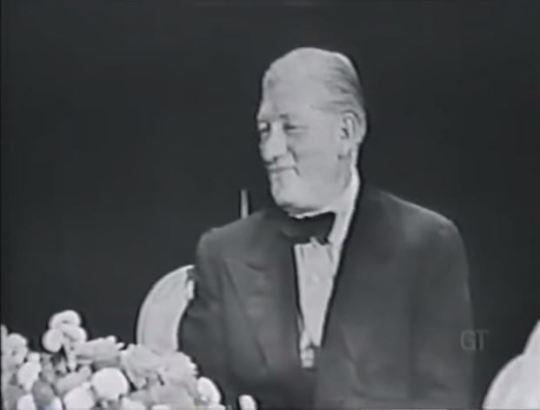
Howard Dietz (Himself) was a lyricist who wrote over 500 songs in his lifetime. In 1954 he was a vice-president at MGM where he is credited with developing the Leo the lion logo as well as their slogan “Ars Gratia Artis” (art for art's sake). The Long, Long Trailer was an MGM picture.

Don Dixon (Himself) was a correspondent for INS, the International News Service. He was held captive in Communist China for 18 months.
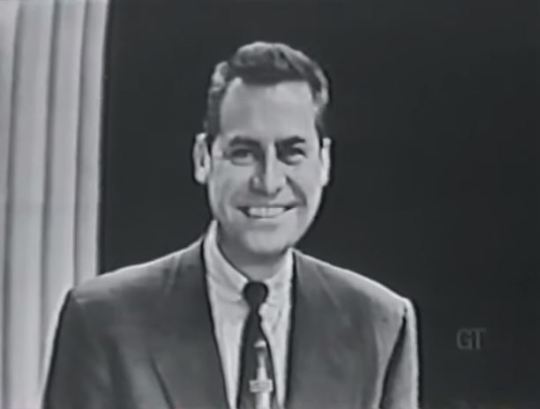
John Hodiak (Himself) was a busy actor at MGM who had co-starred with Lucille Ball in their 1946 film Two Smart People. He was also seen in the 1944 film Lifeboat with Tallulah Bankhead.
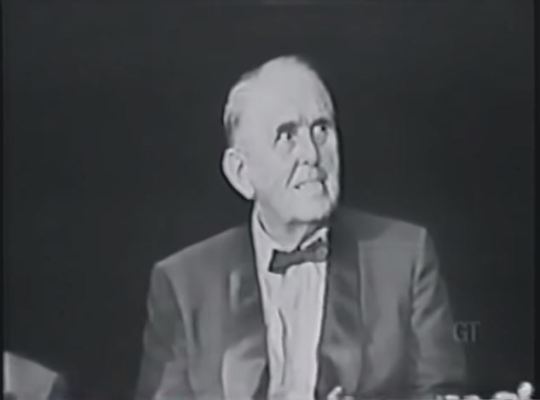
Tex O'Rourke (Himself) was a toastmaster famous for moderating his “Circus Saints and Sinners” tributes.
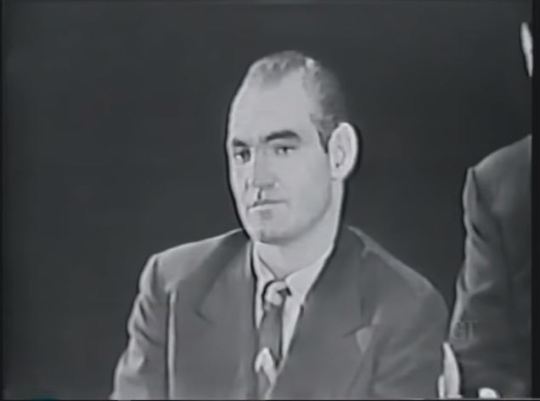
Dusty Rhodes (Himself) was a member of 1954 World Series Champion team the New York Giants. He would return to “The Ed Sullivan Show” in April 1955.
Robert Taylor (Archival Footage from Bataan) acted alongside Desi Arnaz in the 1943 film Bataan. He never appeared on “I Love Lucy,” but during the Ricardo's stay in Hollywood, Lucy Ricardo mentioned meeting him at a farmers market and getting his autograph on an orange.
Keenan Wynn (Archival Footage from The Long, Long Trailer)
Marjorie Main (Archival Footage from The Long, Long Trailer)
Johnny Roventini (Philip Morris Bellhop, uncredited)
Julia Meade (Voice of Mercury Commercial)
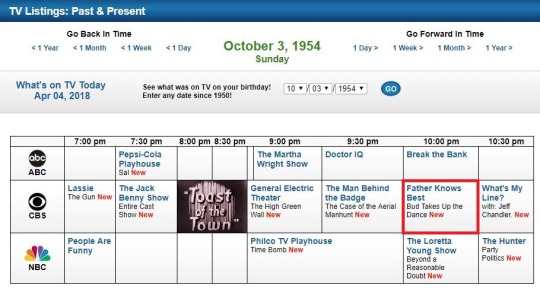
This show was aired on CBS on October 3, 1954. Sunday nights were known as “Ed Sullivan Show” nights in the same way that Lucy and Desi “owned” Monday nights throughout the 1950s. This show was done live in front of a studio audience at (what is now known as) the Ed Sullivan Theatre in New York City.
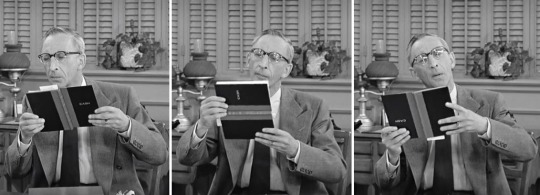
The next day “I Love Lucy” began its fourth season on the air with “The Business Manager” (ILL S4;E1) co-starring Charles Lane (above) as Mr. Hickox. Two weeks later the series celebrated its 100th show.
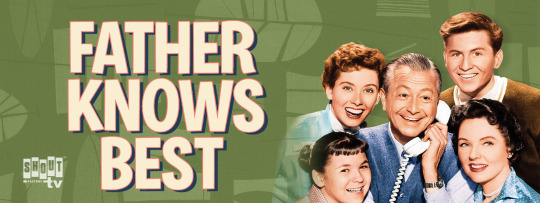
The same night this show aired, “Father Knows Best” made its TV debut on CBS at 10pm. Prior to that the series had been aired on radio since 1949. On TV, it ran for one season and was canceled. The series was picked up by NBC, where it remained for three seasons. After a second cancellation in 1958, the series was picked up yet again, by CBS, where it aired until May 1960.
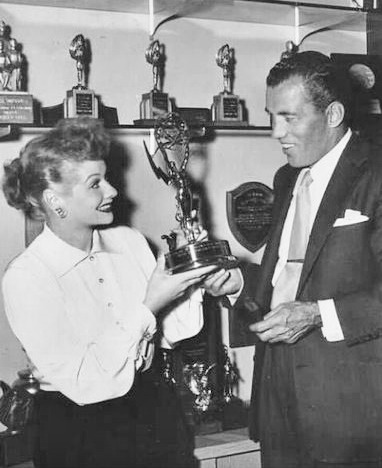
This was the second of Lucille Ball's dozen appearances on “The Ed Sullivan Show.” Ball and Arnaz had been on earlier in the year, after Ed Sullivan presented “I Love Lucy” with an Emmy Award in April 1954. Desi made eight appearances, the last being in 1960. This is the only time the full hour of Sullivan's show is devoted solely to Lucy and Desi.
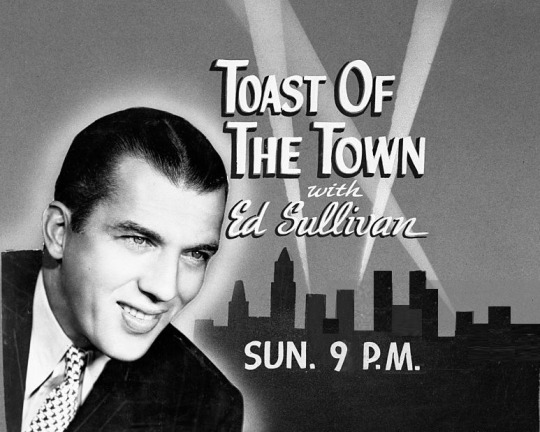
“Toast of the Town” was not filmed in Hollywood, like “I Love Lucy.” It was broadcast live from New York and then kinescoped to the West Coast. Consequently, prints of this show are generally of poor quality.
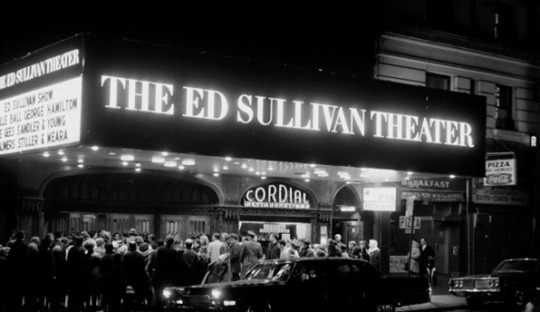
During the run of “I Love Lucy,” Ed Sullivan and his show were mentioned several times:
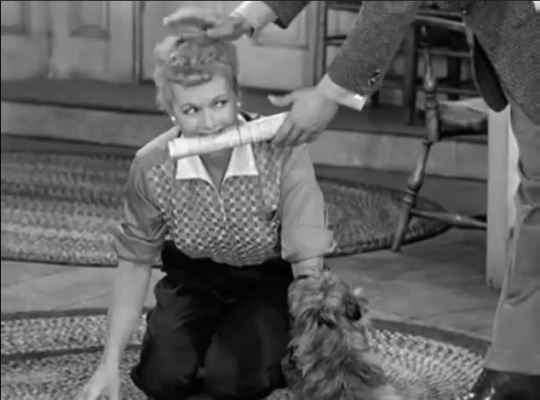
Lucy: (about Fred the dog) “He learned obedience, but he’s not ready for ‘The Ed Sullivan Show’.”
~ “The Ricardos Dedicate a Statue” (ILL S6;E27)
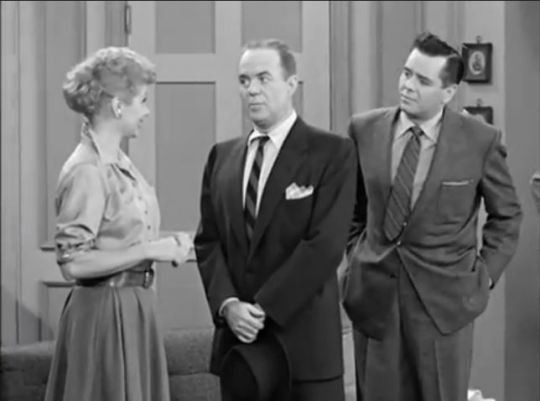
Johnny Clark: (to Ricky) “I think I've got you planted on ‘The Ed Sullivan Show’ for next month.”
[Celebrities would often be asked to stand-up and wave if they were spotted on “The Ed Sullivan Show.”] ~ “Face to Face” aka “The Ricardos Are Interviewed” (ILL S5;E7)

Lucy: (to a stoic Buckingham Palace Guard) “Wow, you make Ed Sullivan look like laughing boy.”
[Sullivan was known not to smile or laugh, something Lucy chides him for in the tribute.] ~ “Lucy Meets the Queen” (ILL S5;E15)
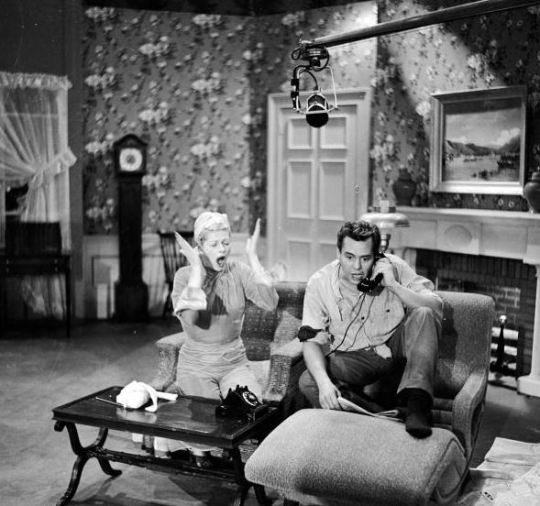
To kick off the hour, Lucy and Desi perform a sketch about their meeting with Ed Sullivan. Although the sketch feels like an episode of “I Love Lucy,” Lucy and Desi use their own names. It opens with Lucy knitting and Desi at home (in Beverly Hills), relaxing and reading the Sunday papers, which are spread out all over the room. Desi is looking for the “spor' session” [“sports section”].
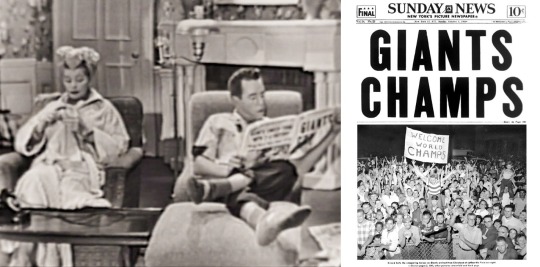
The newspaper Desi holds is the Sunday, October 3, 1954, edition of the New York Daily news, with the back page headline “GIANTS CHAMPS”! The previous day, the New York Giants triumphed over the Cleveland Indians in the 1954 World Series. Interestingly, this was not good news to Lucy's good friend Bob Hope, who was part-owner of the Indians.
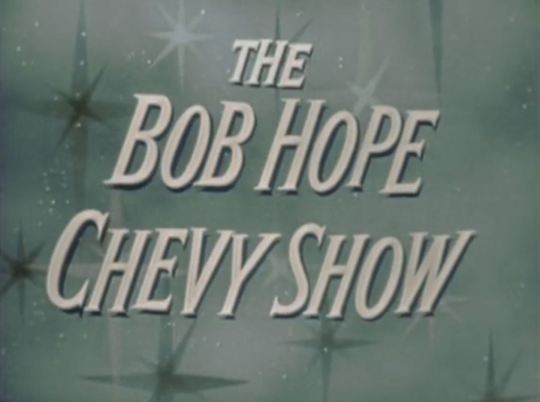
Two years later, October 8, 1956, Lucy and Desi guest-starred on “The Bob Hope Chevy Show” which for the evening was broadcast in Ed Sullivan's time slot, a fact Hope acknowledged in his monologue. Like this Ed Sullivan show, it was the day after a world series victory and the MVP was invited to appear on the show. For this “Toast of the Town” that player was Dusty Rhodes of the New York Giants. In 1956 it would be Don Larsen of the New York Yankees.

When Lucy shows off what she's been knitting, Desi immediately jumps to conclusions: “Lucy! Again? We've already done that bit!” Desi is referring to Lucy Ricardo having a baby on “I Love Lucy.” Prior to that, in 1951's “Drafted” (ILL S1;E11, above), Ricky and Fred mistake the girls knitting them sweaters for a clue that they are expecting.
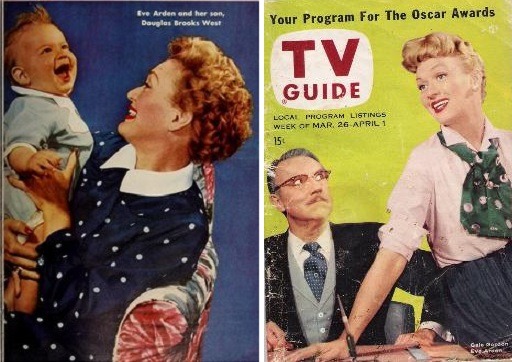
Lucy tells him to relax, that she's knitting it for Eve Arden's new baby. Arden, a friend of Ball's from her B-movie days, was currently starring in TV's “Our Miss Brooks” filmed at Desilu. On September 17, 1954, she gave birth to what would be her only biological child, Douglas Brooks West.
After arguing who should answer the telephone, Desi answers it, but can't quite figure out who it is on the other end.
Desi (to Lucy, covering the phone receiver): “I think it's somebody from a bakery. A guy called Solomon. Ed Solomon. He says he's selling toast in this part of the town.”
Lucy grabs the phone and it turns out to be Ed Sullivan who is coming right over, despite the fact that their house is a mess and they aren't properly dressed. Desi says they should let Ed see them as they really are, with no pretense.
Lucy: “The show is called 'Toast of the Town', not 'Crumbs of the Town'.”
She then implores Desi to put on his shoes, to which he replies, “What for? He knows I got feet.”
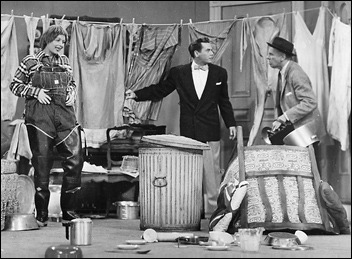
This is very similar to an exchange in “Men Are Messy” (ILL S1;E8) from 1951.
Lucy Ricardo: “Put your shoes on and pick up those papers. Company is coming.” Ricky Ricardo: “It isn't company, it's Fred and Ethel.” Lucy Ricardo: “Well, put your shoes on.” Ricky Ricardo: “They know I have feet.”
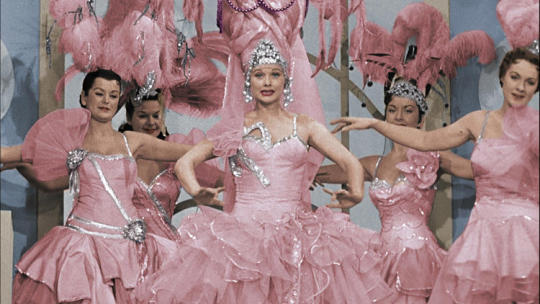
In the next scene, they are dressed to the nines, and Lucille makes her entrance to the strains of “A Pretty Girl Is Like A Melody” by Irving Berlin. In 1955's , “Lucy Gets Into Pictures” (ILL S4;E18) Lucy Ricardo gets a role as a showgirl, strutting down a staircase wearing a giant head-dress, while this song is playing.
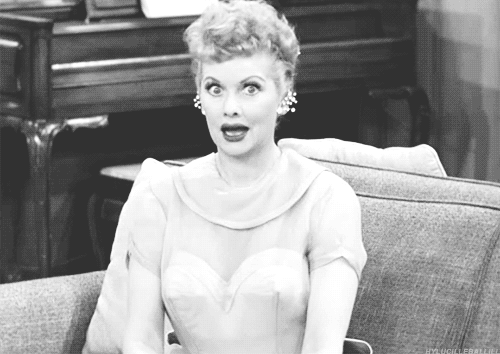
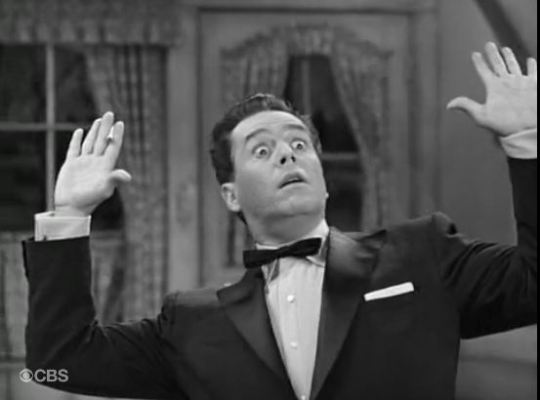
Before Sullivan arrives, Lucy and Desi silently practice being acknowledged from the audience, just in case that is what Sullivan has in mind. This is visually similar to when Lucy and Ricky rehearse being surprised with a “Housewarming” (ILL S6;E23) party when they first move to Connecticut in 1957.
The phone rings again and Lucy talks to their agent Don Sharpe about the purpose of Sullivan's visit, while Desi hovers anxiously behind her:
Lucille (into the phone): “He is! He isn't? He isn't? He is! He isn't!” (she hangs up) Desi: “Well, is he or isn't he?”
This is another gag taken directly from “I Love Lucy.” It is possible that the “I Love Lucy” writers participated in the scripting of this sketch.
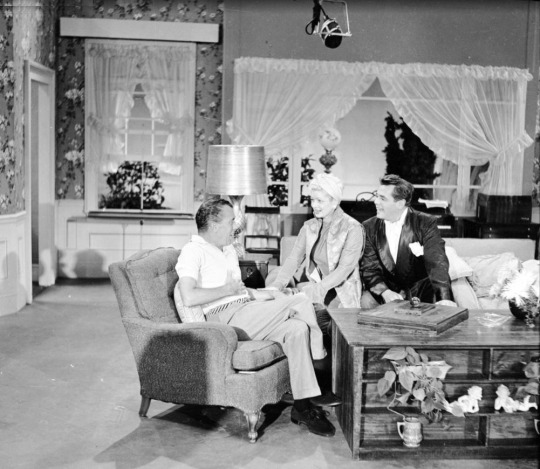
When Sullivan finally arrives at the Arnaz home, they rush him off his feet and pretend not to have already heard the news. Sullivan finally spills the beans.
Lucy: “'Toast of the Town' and the whole slice about us!”
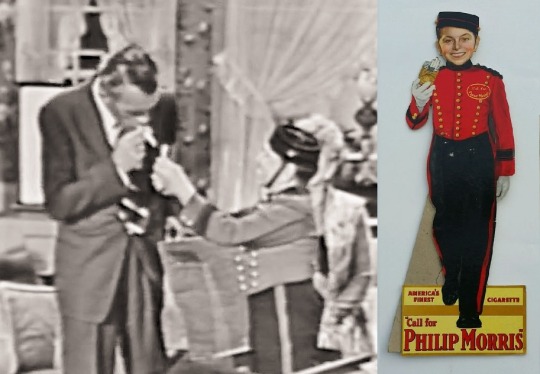
When Sullivan asks Lucille for a cigarette, the Philip Morris bellhop Johnny Roventini literally pops out of the coffee table and gives him one! Although Philip Morris was not a sponsor of “Toast of the Town,” the gag acknowledges the company's initial support of “I Love Lucy.”
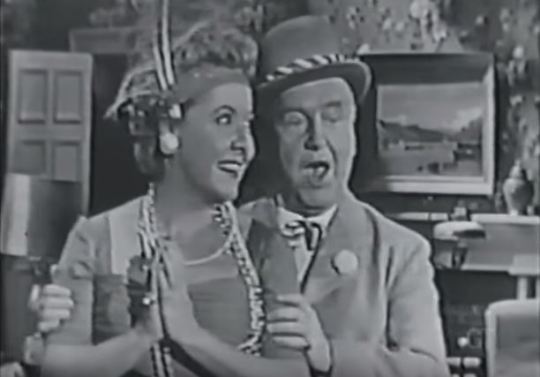
Vivian Vance just happens to drop by – and then almost immediately Bill Frawley. The just happen to be ready to regale Sullivan with a song, “Hullaballoo,” which Frawley says is an old vaudeville tune from 1913. He also claims that they previously performed it “on one of the old Lucy shows” but no such song was ever sung by Fred and Ethel on “I Love Lucy.”
A curtain then closes for their bows. Sullivan reminds Vivian that they last met when he presented the Emmy Award to “I Love Lucy” in Hollywood. He recalls first meeting Frawley in Leone's Restaurant. Jimmy Walker introduced him to Sullivan. Walker was mayor of New York City from 1926 to 1932, when Sullivan was a news correspondent.
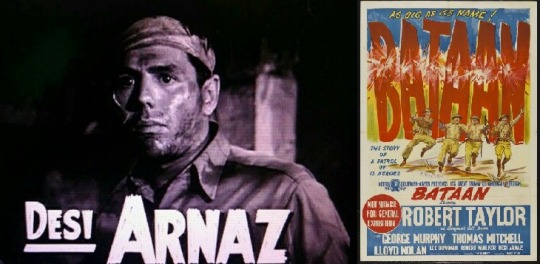
Sullivan discusses the film Bataan featuring Desi Arnaz and Robert Taylor. Baatan (1943) was an MGM film about the World War II Battle of Bataan, a region of the Philippines.
youtube
After a Mercury commercial narrated by Julia Meade, Ed Sullivan introduces the trailer from The Long, Long Trailer, a 1954 color film based on a novel of the same name by Clinton Twiss. It is about a couple who buy a new trailer home and spend a year traveling across the United States.The film stars Lucille Ball as Tacy Collini and Desi Arnaz as Nicky Collini. The characters' names were changed from the book to sound more like ‘Lucy and Ricky’ (Tacy and Nicky, say it fast).
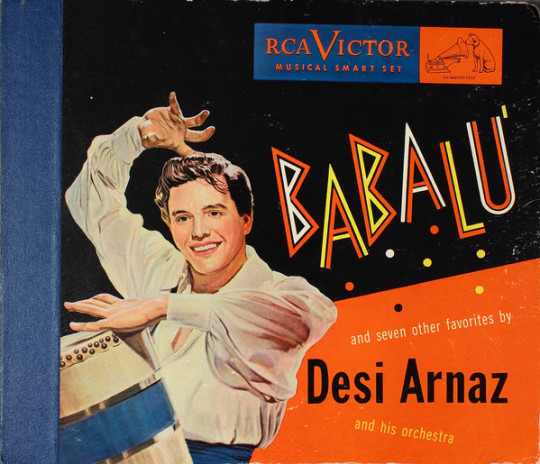
Desi Arnaz performs his signature song “Babalu.” He performed the song on “I Love Lucy” in "The Audition" (ILL S1;E6) and in "The Ricardos Visit Cuba" (ILL S6;E9), where Desi was joined by Richard Keith (Little Ricky). Other times it was partially heard or sung for comedic purposes, such as in "Lucy Hires an English Tutor" (ILL S2;E13), “Ricky's Life Story" (ILL S3;E1), "The Publicity Agent" (ILL S1;E31) and “The Young Fans" (ILL S1;E20). Desi Arnaz first recorded the song in 1947, although he had performed it as part of his nightclub act prior to that.
After Desi finishes singing, Sullivan tells his audience that Desi has had a fever of 101 all day, but insisted on singing “Babalu” anyway.
Finally, the "Circus Saints and Sinners Luncheon" begins, a formal tribute (the actual “Toast” of the town) with speeches from and about the Arnazes.
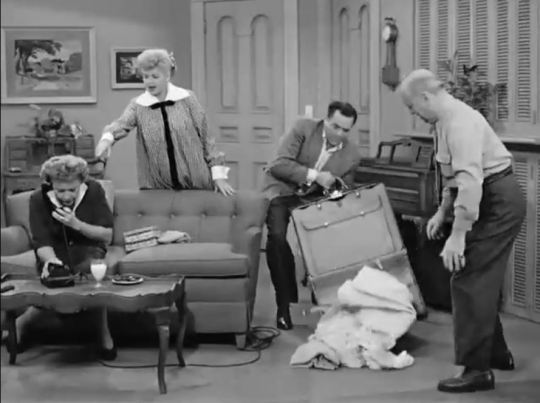
A clip from “Lucy Goes to the Hospital” (ILL S2;E16), which first aired on January 19, 1953. This was Desi Arnaz’s favorite episode.This is the episode that made “I Love Lucy” a national phenomenon. It is estimated that 72% of the American public who owned a television tuned in to see the birth of Little Ricky. His birth was timed to coincide with Desi Jr.'s birth, that same day. This episode aired the day before the inauguration of President Eisenhower and five months before the coronation of Queen Elizabeth II. More people watched this “I Love Lucy” episode than either one of those televised historic events.
To kick things off, Ed Sullivan reads a letter from Bernard Baruch (1870-1965). Baruch was a financier and powerful political consultant who had served with Sullivan on a Government-appointed Entertainment Committee to bolster post-war morale in America.
Toastmaster Tex O’Rourke discusses Ball and Arnaz’s childhoods and their early work in show-business.
Baseball player Dusty Rhodes some brief comments of his own.
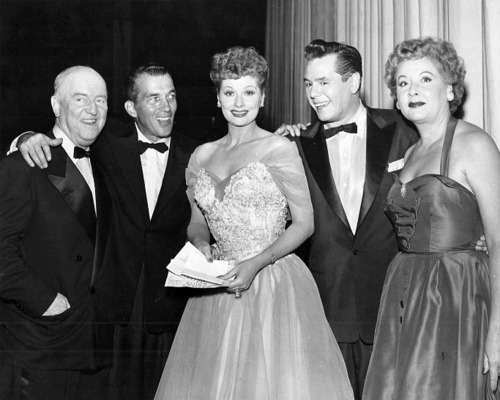
Lucille Ball is first to make her remarks, thanking the networks and production staff of “I Love Lucy,” and ultimately Desi:
Lucy: “This guy, who seems to be in all places at once, making like an actor, a banker, a politician – in short, a producer – gets my vote as the greatest producer of all time. And I have two little Arnazes at home to prove it.”
Desi Arnaz expresses his appreciation to Lucy and the United States of America for giving him the opportunities he has enjoyed.
Desi: “We came to this country and we didn't have a cent in our pockets. From cleaning canary cages to this night in New York is a long ways. And I don’t think there’s any other country in the world that could give you that opportunity.”
Both Lucy and Desi become visibly emotional while making their speeches. "Desi was very sincere about that," said Madelyn Davis, who along with her partner, Bob Carroll Jr., wrote every episode of the first four seasons of “I Love Lucy” with Jess Oppenheimer. "Lucy got teary and even Ed Sullivan. Desi wasn't kidding. They had nothing."
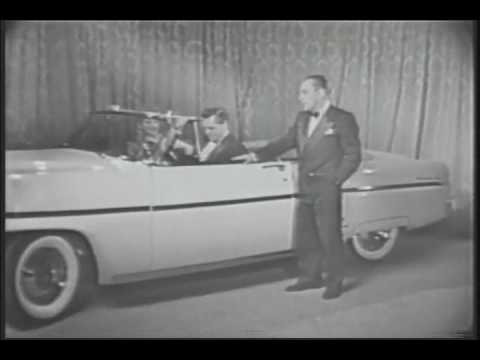
The show includes Lincoln Mercury commercials starring Ed Sullivan. Lucy and Desi had participated in such commercials in their first appearance on “Toast of the Town” in April 1954. During the sketch that starts the show, Lucy says the words “High dramatic” and Ed reminds her that on his show, it is “Merc-O-Matic,” which was Lincoln Mercury's own automatic transmission, introduced in 1951.
This Date in Lucy History – October 3rd

"Lucy Visits Grauman's" (ILL S5;E1) – October 3, 1955
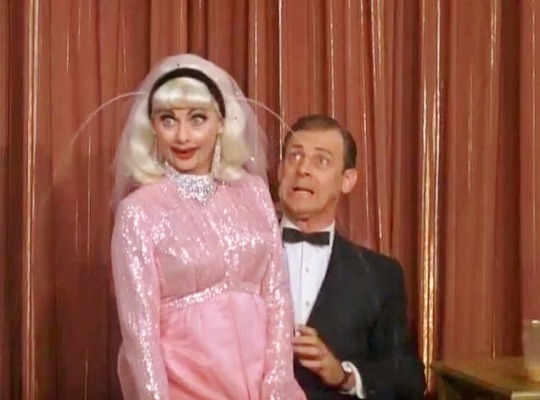
"Lucy and Paul Winchell" (TLS S5;E4) – October 3, 1966
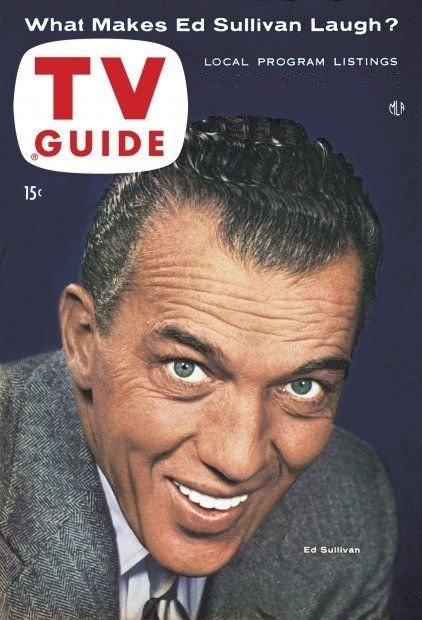
#Toast of the Town#The Ed Sullivan Show#Ed Sullivan#Lucille Ball#Desi Arnaz#I Love Lucy#Vivian Vance#William Frawley#1954#CBS#John Wray#Harry Chesney#Johnny Roventini#Howard Dietz#Don Dixon#John Hodiak#Tex O'Rourke#Circus Saints and Sinners#Dusty Rhodes#New York Giants#Robert Taylor#Bataan#Keenan Wynn#Julia Meade#Marjorie Main#The Long Long Trailer#MGM#Eve Arden#Don Sharpe#Hullabaloo
2 notes
·
View notes
Photo

New Post has been published on https://deutschstyle.net/2018/03/22/danner-stiefel-fur-manner-spezial-schuhe-funktion.html
Danner Stiefel Für Männer – Spezial Schuhe Funktion

Seit 1932, Danner hat mit der Produktion von erschwinglichen, hand-made Arbeitsstiefel. Mit Hauptsitz in Portland, Oregon, Danner produziert auch Jagd-Stiefel, Militär-grade-Springerstiefel, wanderstiefel und Schuhe für die Strafverfolgungsbehörden.
Aber es ist die Arbeit Stiefel, die Danner produziert für den amerikanischen Arbeitern gemacht hat, dass Danner ein bekannter name in Geschäften und auf Baustellen im ganzen Land.
Danner hat seinen Anfang während der Großen Depression in Chippewa Falls, Wisconsin, einer alten holzfällerstadt, die sich an den ufern des mächtigen Mississippi River. Danner ‘ s original 12 Mitarbeiter gebaut Danner die erste Leder-Stiefel durch hand, Sie zu verkaufen, Holzfäller für $ 4 ein paar.
Vier Jahre später, im Jahr 1936, Charles Danner, der Gründer des Unternehmens, zog mit seiner Familie und seiner Firma in Portland, wo die Firma noch heute befindet.

Was setzt Danner abgesehen von anderen Schuh-Unternehmen ist die Marke das langjährige Engagement zu produzieren, American-made-Stiefel hergestellt aus top-Regal, Leder und Gummi.
Die Produkte des Unternehmens sind so gut eingehalten, dass die verschiedenen Abteilungen der US-Streitkräfte getragen haben, Danner Stiefel im Kampf seit 1982.
In diesen Tagen, Danner ‘ s Erbe-inspirierte hiking-Stiefeln und ultra-robuste Arbeit Stiefel haben sich zu einem Stil-Grundnahrungsmittel für trendige Menschen Leben in Asien, Nordamerika und Europa.
Meine top 3 persönlichen Lieblings-Danner-Stiefel:
Danner Mountain Pass Mink Oil
FELD-HIER GETESTET
Der Danner Mountain Pass bietet ” out-of-the-box-Komfort, die selten in einem wanderschuh. Dieses leichte boot verfügt über eine integrierte shank, Zwischensohle und dauerhafte Bord. Bei nur 46 oz. ein paar, Sie sind perfekt für Wanderungen durch dicken Pinsel oder lange Arbeitstage.
Dank der herausnehmbaren OrthoLite-Fußbett, lange Wanderungen sind ein Kinderspiel. Kombinieren Sie diese mit einer dünnen Vibram Kletterlift-Laufsohle und Sie erhalten eine vollständige Palette von Bewegung mit jedem Schritt. Obwohl diese Stiefel sind nicht wasserdicht, Sie verfügen über eine Dri-lex-liner, die hat eine ausgezeichnete Arbeit halten Sie Ihre Füße trocken.
Danner zusammengeführt Stil mit Funktion, so können Sie sport diese gutaussehenden Stiefel der Kneipe oder in einem Lager. Eine Wildleder-Zunge protector und rot Schnürsenkel-die perfekte Akzente. Wenn im Gegensatz gegen die Nerz-öl-Schaft, geben Sie die Stiefel im retro-look. Mit einem Leder-Zunge und gepolsterter Kragen, Sie erhalten eine sichere, bequeme Passform.
Danner Steinbruch Braun-Legierung Zehe-Keil
FELD-HIER GETESTET
Wenn Sie in den Markt für eine harte Arbeit-boot, erfordert keine break-in Zeit, diese handgefertigte Stiefel ist ein Bauarbeiter Favorit. Der erste Steinbruch-boot wurde eingeführt vor über einem Jahrzehnt und weiterhin den test der Zeit stehen. Gebaut mit premium-teilen aus der ganzen Welt, Sie bieten alle-Tag Komfort von der Ferse bis zu den Zehen. Ob du stehst auf Beton oder müssen einen festen Stand auf rutschigem Untergrund, dem Steinbruch, der Ihnen hilft, den job zu erledigen. Eine gepolsterte, nicht-Markierung, slip und ölbeständig-Keil-Sohle entlastet Druck und Griffe alle Arten von Gelände. Mit einem triple-stitch design und eine 12-Eisen-Vibram-Zwischensohle, können Sie sicher sein, dass diese Stiefel dauern wird.
Sie bieten eine bequeme Passform an der Ferse und haben eine Breite Alu-Zehen-box und gibt den Zehen genügend Spielraum. Die Gore-Tex-gleichzeitig wird verhindert, dass Wasser sickern durch, indem der Weg für den Schweiß zu entkommen.
Danner Tanicus
FELD-HIER GETESTET
Danner gepaart rough-out Leder und robusten Denier nylon zu liefern, die einen leichten, komfortablen, langlebigen boot. Für den Mann, der bevorzugt pfiffigen, high-mileage-Schuhe, diese Stiefel sind robust und stilvoll. Über außen sieht, Sie sind mit einem dicken, gepolsterten Mittelsohle zu halten eine Feder in Ihrem Schritt. Das atmungsaktive, Feuchtigkeit-bekämpft mesh Innenschuh hält die Füße kühl im heißen Temperaturen und eine Wasserdichte Barriere bietet überlegenen Schutz in feuchten Bedingungen.
Ein weiteres key-feature ist die Außensohle ist pentagonal lug design, das Stabilität bietet, egal, ob Sie aufsteigend, absteigend, auf das stehen auf unebenem Gelände. Die heels einrasten, so dass Sie eine bessere Passform am hinteren Ende, während eine geräumige Zehenkappe bietet genügend Raum für die Mittelfußknochen. Darüber hinaus die Stiefel verfügen über eine Stoff garage zu Parken lose Schnürsenkel und halten Sie Sie aus, ziehen.
Ob Sie sich für casual Stiefel zu tragen, an den Wochenenden oder eine Arbeit-boot, die gut abschneidet, unter Druck, der Danner Tanicus wird wickeln Sie Ihre Füße mit höchsten Komfort.
Entdecken Danner ‘ s Collection

1 note
·
View note
Text

•Auteur: Charles den Tex •genre: thriller •Uitgeverij: De Geus •Aantal pagina's: 378
0 notes
Photo

Boekenpost 📚 Charles den Tex - Onmacht Maand van het Spannende boek 2010 CPNB + Boekenlegger @charlesdentex #charlesdentex #onmacht #cpnb #2010 #maandvanhetspannendeboek #boekenpost #tbr #gesigneerd #BookMail #bookmail #2ehands #boekenpostbodeisoke #ntl #ntll #leespromotie #boeken #tbrpile #tweedehandsboeken #books #tbrpilekeepsgrowing @cpnb9 @stichtingcpnb #boekenleggers #boekenlegger https://www.instagram.com/p/CE66KysAQcq/?igshid=af7jcincax8b
#charlesdentex#onmacht#cpnb#2010#maandvanhetspannendeboek#boekenpost#tbr#gesigneerd#bookmail#2ehands#boekenpostbodeisoke#ntl#ntll#leespromotie#boeken#tbrpile#tweedehandsboeken#books#tbrpilekeepsgrowing#boekenleggers#boekenlegger
0 notes
Text
mening boek cel
Ik heb nu dus eindelijk het boek, cel van Charles den tex uitgelezen. Maar wat vond ik er eigenlijk van? Ik vond het eerlijk gezegd best saai. De eerste 150 pagina's vond ik nog wel leuk, maar daarna gebeurde er niks, maar dan op het einde begon het weer interessant te worden. Het bleef ook altijd hetzelfde: Michael die word geachtervolgd. Het was zeker geen slecht boek, maar ik zou het niet aanraden!
2 notes
·
View notes
Text
Hallo!
Vandaag komen jullie eindelijk te weten welk boek ik ga lezen.
Voor ten laatste 1 november zullen al mijn werkjes over dit boek online staan dus vergeet niet af en toe op mijn profiel te kijken :)
Het boek dat ik ga lezen is... “Cel” van Charles Den Tex.
Uitgever: De Geus
Jaar: 2018
Aantal pagina’s: 384
Het gaat over iemand die getuige is van een auto-ongeluk maar hij wordt aangehouden. Op het politiebureau wordt hij ondervraagt door twee rechercheurs, er is een onontkoombaar bewijs en zijn advocate gelooft hem niet. We komen te weten dat iemand zijn identiteit gebruikt...

0 notes
Text
The Great American Chile Highway
The 643-mile stretch of Interstate 25 between Las Cruces, New Mexico, and Denver skips across time and terrain like few other American trails.
The highway passes through settlements that date back to before Columbus and through brand-new housing tracts with Subarus in the driveway. It cuts through lush valleys and staked plains, metropolises and ghost towns, tree-blanketed mountains and punishing deserts. Through majority-Mexican villages, and suburbs whiter than the Rocky Mountain snowpack.
Travelers have trekked this passage for centuries, always with care. Conquistadors named the area around the southernmost section the Jornada del Muerto — Journey of the Dead Man — because of how unforgiving it was. To this day, drivers try to rush over the Ratón Pass (elevation 7,834 feet) that separates New Mexico and Colorado before sunset, lest they get caught in bad weather. And that weather: It can switch from sleet to fog to dust storm to snow to rain, all in the space of a couple of miles.
It’s not a route for the faint of heart. But I did it. And my fuel was the one thing that unites the disparate communities along the way — chile.
Chile peppers are the Southwest’s most famous gastronomic expression: grown and packed and used for decoration, grilled and dried and frozen, and eaten all year in the region. On I-25, however, “chile” is as varied as the land and people. It’s the pepper, for sure, but also a salsa that can be as thick as gravy or as thin as water, mellow or scorching. “Chile” also appears as a cheeseburger, a snack, a meat rub. A full meal or an appetizer. A bowl or a plate. A soup or chicken-fried steak or burrito drowned (“smothered” in local parlance) in it. Red or green chile or both, a style called “Christmas.” Dessert. Heritage. Life.
Over three days, I saw and tasted how restaurants along the Chile Highway approach their spicy muse. The dishes here rarely venture far from what’s now I-25 because their essence is tied to the chiles grown along the route. No other peppers in the world will do, so home cooks and chefs and packing companies roast freshly harvested green ones every fall to use immediately (and freeze leftovers for the future), or dry the red ones to make powders, flakes, or ristras (vertical bouquets of dried peppers). Either way, a guaranteed, year-round supply is always near.
From this shared ingredient bubbles up a dazzlingly diverse food scene that stretches way beyond Santa Fe and Hatch, the two stops on the Chile Highway that food media focus on at the expense of the rest. Great grub at American Indian-run gas stations. Burger empires. Hyper-regionalism — Cruces-Mex, Den-Mex, Pueblo-Mex, and so much more. (Read Eater’s Definitive Guide to Santa Fe Green Chile.)
I ended up eating “chile” 38 different ways — and I could’ve done more. But caution to the curious: Take the trip in doses, not in one fell swoop like me. Like Icarus, I flew — or rather, ate — too close to the heat. At times, I felt like the trip might actually turn me into a living Human Torch. But like the Phoenix, I rose from the proverbial ashes, spitting nothing but fire.
And the ordeal was worth it.
To outsiders, the food of the Southwest is synonymous with Mexican, mostly because the cuisines share the same foundation: tortillas, combo plates, an emphasis on meats, and especially chiles. But over the past 400 years, residents have fused the traditions of the region’s three main ethnic groups — Mexican, white, and American Indian — to create a gastronomy that belongs to all three yet stands on its own.
These foodways found their most lasting expression in New Mexico, where the state’s Hispanics (known as Hispanos, because many trace their ancestry to conquistadors) settled the northern part of the Land of Enchantment in the 1600s, remaining in relative isolation until the federal government began to pave roads connecting Albuquerque and Santa Fe to the greater U.S. after World War II. Removed from constant replenishment from Mexican migration like, say, Cal-Mex and Tex-Mex, much of New Mexican food remained largely frozen in time.
Or so I thought.
Before my expedition, I vowed not to commit the sin of so many before me: to think of New Mexico as a place where time ran slower than in the rest of the country, and the culture was fossilized, and therefore ripe for exotification.
“It is the Great American Mystery — the National Rip Van Winkle — the United States which is not United States,” wrote Charles Fletcher Lummis in his 1893 book Land of Poco Tiempo. “Why hurry with the hurrying world? The ‘Pretty Soon’ of New Spain is better than the ‘Now! Now’ of the haggard States.”
Even when Southwestern cuisine had its national heyday in the 1980s — when chefs like John Rivera Sedlar and Mark Miller garnered attention for fusing local ingredients with French techniques — reporters and critics depicted the movement’s acolytes as necromancers resurrecting dormant, overlooked riches long forgotten by the locals.
That idea, however, robs the Chile Highway’s denizens of their agency. The people here easily change with the times while keeping true to their chile heritage — it all depends on who’s doing the eating and where. That pride and flexibility characterized my first day.
My journey began in Belen, a city of about 7,000 near the geographical center of New Mexico. At Sandra’s New Mexican Restaurant, I ordered a bowl of posole, which called back to the old ways, spelled with an S (like Spanish friars wrote it out in the 16th century) instead of a Z (the way you find it written out today across Mexico). There was no oregano or cabbage or even lime as toppings — just pork chunks and hominy. And the posole came white, with red chile on the side.
I wasn’t familiar with this presentation, but it didn’t matter: Sandra’s posole was porkier than ramen — the chewy meat, the unctuous broth, the fat kernels. Splashes of red chile opened up its flavors further.
But before I could romanticize New Mexican cuisine as an atavistic treasure, I next gorged on Milly’s Burrito Plate at Alejandro’s Café, five minutes down the street: a great beef burrito buried under french fries and smothered in a fine green chile. It was heavy for breakfast, but it didn’t take long for me to realize that hefty, hearty breakfasts are common throughout New Mexico. Mornings are chilly all year, and there’s nothing like spice and starch to insulate your insides.
My next stop was about 45 minutes south, at San Antonio Crane, named after the small city of San Antonio, as well as the sandhill cranes that migrate to the nearby Bosque del Apache National Wildlife Refuge every winter. The restaurant, a converted house, was slammed, which explained the slow service for my open-faced smothered hamburger, topped with more fries.
There were no arguments about authenticity or heritage at Sandra’s, Alejandro’s, or San Antonio Crane; there was chile. And that was all I needed.
Two hours later, I rolled into Las Cruces and La Nueva Casita Café, which has served New Mexican classics since 1957. Families fresh from church or dressed in Dallas Cowboys gear sat around the ample dining room slurping menudo with toast on the side, an unusual pairing — and another nod to mutability.
I went with the huevos compuestos, a specialty of southern New Mexico. Two small tostada shells filled with carne adovada, topped with eggs any style, and drizzled with chile, huevos compuestos are like a crunchy Hispano eggs Benedict. This version was saucy and savory and superb, with chile two ways: as a sauce and as carne adovada, pork that’s baked with red chile powder and other spices and serves as the de facto meat of the Chile Highway. Think al pastor, but better.
At La Nueva Casita, the adovada was bright with the freshness of chile sourced from Hatch, the self-proclaimed Chile Capital of the World and the one thing most foodies know about New Mexico. Those peppers made a cameo in my dessert at Caliche’s Frozen Custard, where I chose the New Mexican sundae: two scoops of vanilla custard, layered with candied Hatch peppers and salted pecans. The crunch and sweet and spice made it one of the best frozen desserts I’ve tasted in years.
I visit Hatch every summer, so this time I bypassed it in favor of a challenge. For years, I’ve passed a billboard on I-25 for Arrey Cafe that screams, “World’s Finest Green Chile Cheeseburger.” Now, I had the chance to put that claim to the test.
The green chile cheeseburger is the Chile Highway manifest. It didn’t even exist until after World War II. But New Mexicans quickly fell in love gracias to Blake’s Lotaburger, a local obsession on par with California’s In-N-Out and Texas’s Whataburger; there are 28 Lotaburger locations in Albuquerque alone.
New Mexicans quickly embraced this relative newcomer; New Mexico’s Tourism Department promotes a Green Chile Cheeseburger Trail to attract tourists. It’s just a cheeseburger with green chile on it. But therein is the beauty: Green chile is the condiment you never knew a burger needed. Diced or whole sauteed peppers are spread across the patty — past and present New Mexico, snug between two buns.
San Antonio’s Owl Bar & Cafe claims to have created the burger to feed the scientists who worked on the Manhattan Project. It was closed on the Sunday I visited, so I settled for Arrey.
Its roadside ad is almost correct. Arrey makes a great burger — the patty is loosely packed, the Hatch chile is fleshy and piquant, and their secret sauce is a relishy green salsa that ramps up the heat. The double-fire of green chile and salsa lingered longer than I thought it would, but I didn’t think much of it then.
It was a harbinger of the hell settling into every cell of my being.
When I left Arrey, I realized I faced a problem: All the restaurants I wanted to visit were either not open on Sundays or closed by 3. So I sped off to Albuquerque, grabbing any good bites I could find along the way.
I found plenty. A green chile Philly cheesesteak at Johnny B’s in the town of Truth or Consequences, New Mexico, that I dunked into their sturdy cup of red to create a New Mexican French dip. A Frito pie, a glorious mess of crunch, cheese, and Socorro-style red chile sharper and smokier than Hatch, at the 24-hour El Camino Restaurant, whose wooden booths, kachina figures, and dive-y bar make it look unchanged since its 1963 debut. A juicy adovada burrito in the Los Lunas outpost of the statewide chain Burritos Alinstante, New Mexico’s second-best food empire after Blake’s.
I stopped for gas at the Isleta Travel Center, just outside the Pueblo of Isleta, “Pueblo” in New Mexico referring to what the rest of the United States would call a reservation. New Mexico has some of the best gas station food in the country, because Native American tribes run many of them and frequently stock local goods. The Isleta Travel Center sold green chile piñon nuts last time I visited; this time, I grabbed a bag of Bar X Brand green chile carne seca, dried beef that feels like dehydrated tissue paper but reconstitutes lusciously in your mouth. And, unlike other jerkies claiming to light up your mouth, Bar X brought the fire.
I rolled into Albuquerque at nighttime, but managed to score an adovada plate at Duran Central Pharmacy, and some adovada-stuffed sopaipillas at Sadie’s, two local standbys. After so much savoriness, I needed something sweet, so I swung by Frontier Restaurant, a legendary late-night diner across from the University of New Mexico. Under the gaze of multiple portraits of John Wayne, I picked at one of their massive cinnamon rolls. But I couldn’t shake the chile: Frontier has two large vats of complimentary red and green. I dunked chunks of the rolls in each. Chile as frosting? Divine.
Undergrads of all ethnicities filled up at the chile station. I felt a tingle in my chest as I beheld a post-racial America brought together by the power of red and green.
Or was it all the chile pulsing through my veins?
Every time I visit ABQ, I stop by Barelas Coffee House. This is where friends took me the first time I visited the Duke City, about 12 years ago, and taught me that “red” and “green” in the Southwest mainly concerns chile. A savory bowl of either at Barelas, with their billowy flour tortillas to sop up every last stain, would make you an instant convert to the city, the state, the chile, the everything.
I started Day Two with a bowl of green, then picked up some biscochitos (anise-flavored shortbread cookies) from the venerable Garcia’s Kitchen chain. I needed some snacks to tackle my longest stretch of the drive: 378 miles, ending in Colorado Springs.
It would nearly become my end, period.
I pumped gas at the Warrior Fuel II station in Bernalillo, run by the Santa Ana Pueblo. Tribes across New Mexico have diversified their business holdings this decade and opened restaurants to promote indigenous eats and offer economic opportunities for tribal members. Such a strategy both preserves the past and ensures the future.
Business was popping at Warrior Fuel II, as construction workers and commuters grabbed to-go breakfast burritos from a display case, or served themselves green chile stew from pots. I ladled myself the latter. Pork, potatoes, and strands of pepper, it was like a fiery fall harvest in a Styrofoam cup, no salsa necessary. Even better was the Pueblo Restaurant inside San Felipe Travel Center in Algodones, run by the San Felipe Pueblo. The bowl of red was tasty, but more memorable was the Pueblo taco — fry bread, ground beef, and green chile, fused together with cheese. Even though this is a choice fraught with colonial implications, other tables enjoyed the same, so I set aside my social justice radar and joined in.
Santa Fe gets so much attention that I decided to continue along I-25, making an exception for Cafe Fina, a cute coffee shop on the outskirts of the City Different, whose huevos divorciados, a Mexico City desayuno of eggs and ham on a lightly fried corn tortilla, were Hispano-ized with Christmas chile instead of red and green salsa. Afterward, I wound my way around the snow-dusted Sangre de Cristo Mountains to the hardscrabble hub of Las Vegas, New Mexico. I liked my juicy, smothered adovada burrito at Maryann’s Famous Burrito Kitchen, but far better was a spot I didn’t expect much from: Charlie’s Spic & Span.
It looks like a tourist trap, with neon signs and goofy paintings, like the cover of Whipped Cream and Other Delights. But behind all the kitsch is a great diner. The adovada skillet, sizzling with runny eggs and potatoes, was breakfast at its best. The flour tortillas were so fluffy that I grabbed a still-steaming bag of them from a table near the cashier on the way out.
But after Charlie’s, I ran into bad luck: The restaurants at every town between Las Vegas and Raton were closed. The hangry was real when I finally reached Enchanted Grounds Espresso Bar in Raton, a cowboy town on the old Santa Fe Trail. It was 2 p.m., and the cafe had run out of food for the day.
“Where else should I eat?” I asked the nice woman behind the counter.
“Nowhere today, really,” she responded. “Everything good is closed on Monday. And everywhere closes around this time. Pretty silly, if you ask me.”
I bought some hot chocolate to wash down buttery green chile piñon brittle and my disappointment. Off to Trinidad, Colorado, a funky mining town that, according to free magazines in the local convenience stores, had been a hub of Mafia activity during prohibition. There were more Italian restaurants than Mexican ones in downtown Trinidad, and pasta was the star at Tony’s Diner.
I also found something that’s rare on Southwestern menus: a bowl of chile caribe. It’s red chile made with dried peppers instead of fresh, which creates a spicier, deeper flavor. It was one of the best bowls I’d ever tasted, and a great introduction to Colorado-Mex.
Hispanos settled southern Colorado in the 1850s, and many manitos (the nickname their descendants go by) feel greater kinship with northern New Mexico than they do with Colorado. The result is food as removed from New Mexican food as New Mexican is from Mexican, with added influence from European immigrants (especially Italians), whose presence in the area goes back more than a century. It’s one of the few branches of the Mexican food tree where such a mix causes little grumbling — because chile.
Take Corine’s Mexican Restaurant in Walsenberg, a city of 3,000. Open since 1957, the diner’s best entree is Pollo de Colorado, fried chicken strips topped with a thick red chile. The result tasted like Mexican schnitzel, and simultaneously lifted my tired body while weighing down my gut.
The chile was even better at Three Sisters, a honky-tonk bar in Colorado City. Prominent on the menu was a bowl of Pueblo-style green made from the Mirasol pepper, which manitos grew for over a century and is currently being prepped for its national day in the sun by Italian-American farmers in the San Luis Valley.
Sorry, New Mexico: Pueblo peppers and their incarnations beat all of your chiles. Just a cup of it at Three Sisters showed why — it was more intense than Hatch, more pungent than Socorro, and as rare as Chimayó. (Colorado growers only harvested about 600 acres of peppers last year, compared to the 8,000 or so that New Mexico registered.)
Mirasol love was all over Pueblo, a city with its own distinct cuisine. There, the most beloved treat is the Slopper, a hamburger patty in a sea of green chile: bar food, bar none. Downtown’s Gray’s Coors Tavern claims to have invented it, and their version is particularly wonderful.
Better were the chicken tacos on white at Polito’s Beer Barrel, a neighborhood dive just a minute away from one of the last operating steel mills in what was once called the Pittsburgh of the West. The “white” refers to flour tortillas, and Pueblo makes them thick and salty, then fries them for tacos so that the end result tastes like pita chips. As a side, Polito’s offered fideo, Mexican-style vermicelli noodles which I’ve eaten my entire life in soup, but were here closer to a cumin-heavy spaghetti. Fried flour tortillas also made the base for a gigantic tostada at Estela’s Mill Stop Cafe, with a side of rice so soaked in tomato sauce that it was basically a broth.
I left Pueblo with a Reskie Burger — patty, pimento cheese, and extra Pueblo chiles — from Bingo Burger, and a desire to find ever more Pueblo-Mex. But I could only take one bite before my body finally shut down.
Bluntly put: You try eating chile 27 ways over just two days. It hurts.
The 45-minute drive to Colorado Springs was one of the most uncomfortable of my life. My digestive tract was fine; it was the rest of my body that burned. My eyes felt like they could shoot an optic blast like Cyclops from the X-Men. My skin was warm; my sides began to spasm.
I didn’t sleep that night, constantly waking to the thought of green and red Christmas-ing me with a slow, agonizing, delicious death.
The dish that started my next day, at King’s Chef Diner, looked simple enough: a small bowl of green chile stew, made from Mirasol peppers. No meat, no beans, no nada — just the chile as a soup, with flour tortillas on the side. I had overslept from the previous night’s pain. But with one sip, my troubles disappeared.
What a bowl! Thick, like a comforting Mexican hot chocolate. I was now so hungry that I even scarfed down a huge breakfast burrito at the nearby Rudy’s Little Hideaway, the Pueblo green chile inside zippy and caliente. Rejuvenated, I zoomed to Denver for lunch at La Fiesta. Along a highway defined by restaurants with haphazard hours, La Fiesta probably has the weirdest: open only for lunch, Monday through Thursday; until 9 p.m. on Fridays; and closed on weekends. La Fiesta is special to me, though, because this is where I first tasted Den-Mex over a decade ago.
The Mile High City’s contributions to Southwestern food aren’t just a galaxy apart from Mexican; they���re an entire universe. Chiles rellenos are enveloped in wonton wrappers, then fried. The green chile has an orange tint, not as a shoutout to the Denver Broncos, but because of all the tomato. It’s more like a stew than a sauce, yet it’s consistently hotter than chile in New Mexico (albeit less hot than Pueblo-style).

Huevos divorciados from Cafe Fina in Santa Fe
The region’s favorite supper is the Mexican hamburger — a bean-and-chicharron burrito, smothered, with a hamburger patty in the middle and cheese melted on top. Even Mexican restaurants, run by Mexican immigrants, carry it to ensure they make rent.
I got my regular order at La Fiesta: the namesake combo platter of a chile relleno, bean burrito, and cheese enchilada, everything greasy and hefty and smothered in green. I visited Las Delicias, a Denver chain that splits the difference between Den-Mex standards and meals like carne asada and carnitas. Then I drove to Colorado Springs, intending to slowly make my way back up I-25 to eat at the mountain towns along the way.
This was a mistake. Most of their Den-Mex restaurants close after lunch, which meant I skipped over multiple cities as I returned to Denver. So sorry, Monument. Lo siento, Castle Rock. Your fault, Centennial.
I did find something interesting at Charito’s House in Larkspur, home of Colorado’s Renaissance Festival. It was a straightforward Mexican restaurant — the owners are from the state of Puebla, and their tacos were great. But their menu impressed me. Under the Lo Traditional section were crispy rellenos, Mexican hamburgers, and green chile.
Traditional to I-25 and nowhere else.
Mexicans have a reputation as culinary chauvinists (much-deserved, I say: Please @ me) who want their cuisine to stay in eternal stasis and who are triggered by the very thought of peas in guacamole. But the Chile Highway presents a third way that even the Mexican immigrants who ran Charito’s could understand: Den-Mex wasn’t their Mexican food, but rather, a long-lost cousin happy to reconnect, wanting only respect from its elders.
Respect we should all give.
My chile belly was grumbling again by the time I hit Urban Sombrero in Englewood, a sports bar surrounded by economy hotels where the Den-Mex is not dialed down. They chopped up and fried chiles rellenos, the easier to dunk them in a better-than-expected green chile. I calmed down with a potent green chile martini at national chain Chuy’s Tex-Mex in Westminster.
This gave me the second wind I needed to complete my Den-Mex holy quartet, the places I always make pilgrimages to whenever I’m in town. A bean and cheese burrito with green chile at Santiago’s, a chain with nearly 30 locations around Denver, was far better than its longtime local rival Chipotle (whose headquarters relocated to Orange County, California, in 2018). A fabulous pork chop prepared adovada-style was smothered in meaty green chile at Señor Burritos. Two moist pork tamales were bathed in green at El Noa Noa, the restaurant where I once dined with anti-immigrant former congressman Tom Tancredo before debating him at a Chicano theater across the street.
I concluded my odyssey with the best Den-Mex of them all: a Mexican hamburger at the Original Chubby’s. I crowned it America’s best Mexican dinner in my 2012 book Taco USA: How Mexican Food Conquered America, because I thought Chubby’s represented Mexican food at its finest — surprising, filling, bueno, and proudly regional.
Chubby’s was a small stand when I covered them, and I fondly remember how you could only order to-go and they covered it with two paper plates stapled together so the chile wouldn’t spill. Since then, the owners have knocked down the original building and erected a multihued palace complete with seats and big-screen TVs. The neighborhood around Chubby’s is quickly gentrifying, but they’re still open from 6 in the morning until 2 a.m., 3 a.m. on weekends, with unending lines of blue-collar patrons.
The Mexican hamburger remains awesome — sticky and mushy and smothered in so much chile that the carton is overflowing. As it should.
Like many of its fellow Chile Highway denizens, the Mexican hamburger will probably never be popular anywhere else, and Chubby’s has never received any national accolades. It’s too working-class, too homely, too fattening, and just not Mexican enough.
Too I-25.
America’s loss. The Southwest’s chile game is strong, and I’m more of a convert than ever. And that’s why, even after eating 37 previous chiles in 60 hours, with my gut bloated and my esophagus irritated, I gobbled up my entire Chubby’s Mexican hamburger — and my appetite has never been happier.
Gustavo Arellano is a features writer at the Los Angeles Times and author of Taco USA: How Mexican Food Conquered America. Fact checked by Pearly Huang Copy edited by Rachel P. Kreiter
Eater.com
The freshest news from the food world every day
By signing up, you agree to our Privacy Policy and European users agree to the data transfer policy.

Source: https://www.eater.com/2019/1/23/18182665/best-new-mexico-chile-restaurants-interstate-25
0 notes
Text
Enkele informaties over mijn boek
Dit is mijn boek.
Auteur: Charles Den Tex
Jaartal: 2008
Uitgeverij: De Geus

0 notes
Text
Koop Opname Met Goedkope <b>Bewakingscamera</b> CoBexrd
Koop Opname Met Goedkope Bewakingscamera CoBexrd. Een heerlijke thriller van Charles den Tex in eenvoudige taal. Over een vrouw die …
0 notes